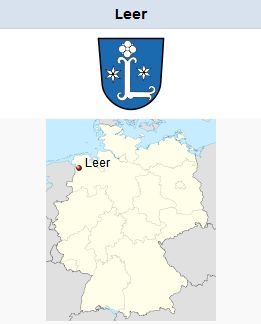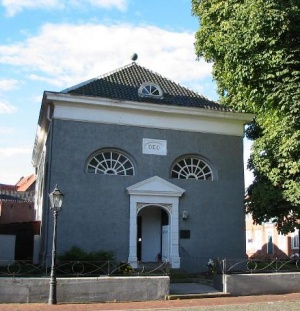Leer (Niedersachsen, Germany)

Leer, a town (pop. 34,000 in 2005) in East Friesland, in the province of Hannover, Germany (coordinates: 53.230833, 7.452778 [53° 13′ 51″ N, 7° 27′ 10″ E]), the seat of a Mennonite church which originated in the early years of the Anabaptist movement. Its founders were probably refugees from Holland and Flanders. It is known that the martyr Elisabeth found temporary asylum here. The family names van Hoorn and Bavink occur in the earliest period. Other Mennonite family names were Alringh, Lulofs, Vissering, Zytsama, and later also Rahusen. Covering the years 1635-1768 there is a Grootboek (financial record) which gives some information on the history of the period. The congregation did not attract much outside attention. It had only a lay minister; for communion, which was called "unity" after 1 Corinthians 10, and baptism, the elder of Emden was called in. During the time of the difficulty with the government concerning letters of protection, etc., nothing is heard of the Mennonites at Leer, perhaps because they had nothing to be extorted from them.

The congregation was said to be Flemish, and as such presumably represented the moderately strict wing in church discipline. Besides this group, there was in Leer also a Groningen Old Flemish or Ukowallist congregation, concerning whose rise and historical development there is no information, but which was in existence by 1660. The two groups united on 24 August 1767. The Old Flemish group had a church at the Kolleweg; this chapel, called "De Schollenberg," which had been the property of the deacon David Joosten (Vissering) was purchased in 1771. It was razed in 1825, and a new church erected with a pleasant garden on the Wörde. A wing was added to accommodate a sexton's apartment and rooms for the church council and for catechism. Two years later an organ was installed. Leer was probably one of the first German Mennonite churches to have an organ. For some years it accompanied only Dutch singing. In fact the services were conducted in Dutch until the 1870s. Untrained preachers of the Old Flemish congregation were Lubbert Alberts, ca. 1680, Harmen Geerts, ca. 1685, Jan Hendriks, 1713-ca. 1740, Jan Warners, 1721-ca. 1742, and Harmen Berentsz Alringh, 1742-ca. 1758.
The last lay preacher of the Flemish congregation at Leer resigned in 1728. For a few years the church was served by Dutch preachers (Doopsgezinde Bijdragen, 1896: 147). Then Cornelius van Campen, also an untrained preacher, was called and ordained as an elder. In the meantime the East Frisian churches centered more and more around Leer, especially in negotiating with the government in financial matters (Müller, 159 ff.). Van Campen introduced a church register, having received government permission to do so. At the same time Norden was also ordered to keep a church record (Müller, 1710). After van Campen (1729-1763) the following served the congregation as pastors: Reinhard Rahusen of Hamburg, 1763-1785; P. Beets, 1785-1789; Hendrick Janssen, 1789-1829; P. Feenstra, 1829-1836; J. Leendertz, 1837-1877; A. G. van Gilse, 1878-1890; and S. F. van der Ploeg, 1891-1920.
The membership of both the Old Flemish and the Flemish congregations always was small. The Old Flemish congregation numbered about 50 baptized members in 1710, 40 in 1733, and 29 in 1754. Of the Flemish congregation there are no figures available before the merger of 1767. The united congregation numbered about 50 baptized members in 1780, 59 in 1840, 73 in 1861, 57 in 1898, ca. 20 in 1935, and 43 in 1955.
After 1920 the pulpit was not filled, and the congregation affiliated with the Mennonite church at Emden, A. Fast serving as pastor here as well as at Emden. After the destruction of Emden in World War II, Pastor Fast made his residence in Leer for a time. The Leer church was incorporated in 1908 and is a member of the Vereinigung. Earlier it had become a member of the Dutch Algemene Doopsgezinde Sociëteit and other Dutch Mennonite associations, and drew its preachers largely from Holland.
Bibliography
Cate, Gerhardus ten. Geslachtslijst van de familie Vissering. n. p., 1903.
Cate, Steven Blaupot ten. Geschiedenis der Doopsgezinden in Groningen, Overijssel en Oost-Friesland, 2 vols. Leeuwarden: W. Eekhoff en J. B. Wolters, 1842. 1 and 2, passim, see Index.
Doopsgezinde Bijdragen (1879) 8; (1902): 226.
Doopsgezind Jaarboekje (1840): 46.
Hege, Christian and Christian Neff. Mennonitisches Lexikon, 4 vols. Frankfurt & Weierhof: Hege; Karlsruhe: Schneider, 1913-1967: v. II, 627f.
Hoop Scheffer, Jacob Gijsbert de. Inventaris der Archiefstukken berustende bij de Vereenigde Doopsgezinde Gemeente to Amsterdam, 2 vols. Amsterdam: Uitgegeven en ten geschenke aangeboden door den Kerkeraad dier Gemeente, 1883-1884. v. II, ,No's. 2794 f.
Müller, J. P. Die Mennoniten in Ostfriesland. Amsterdam, 1887.
Naamlijst der tegenwoordig in dienst zijnde predikanten der Mennoniten in de vereenigde Nederlanden. Amsterdam, 1731 ff.
Maps
| Author(s) | Nanne van der Zijpp |
|---|---|
| Date Published | 1957 |
Cite This Article
MLA style
Zijpp, Nanne van der. "Leer (Niedersachsen, Germany)." Global Anabaptist Mennonite Encyclopedia Online. 1957. Web. 19 Apr 2024. https://gameo.org/index.php?title=Leer_(Niedersachsen,_Germany)&oldid=119031.
APA style
Zijpp, Nanne van der. (1957). Leer (Niedersachsen, Germany). Global Anabaptist Mennonite Encyclopedia Online. Retrieved 19 April 2024, from https://gameo.org/index.php?title=Leer_(Niedersachsen,_Germany)&oldid=119031.
Adapted by permission of Herald Press, Harrisonburg, Virginia, from Mennonite Encyclopedia, Vol. 3, pp. 307-308. All rights reserved.
©1996-2024 by the Global Anabaptist Mennonite Encyclopedia Online. All rights reserved.
